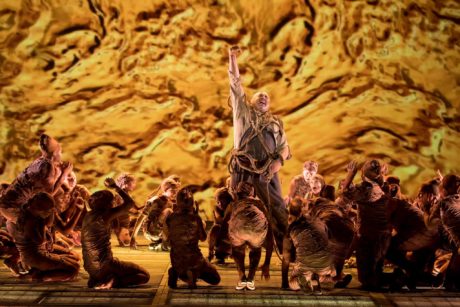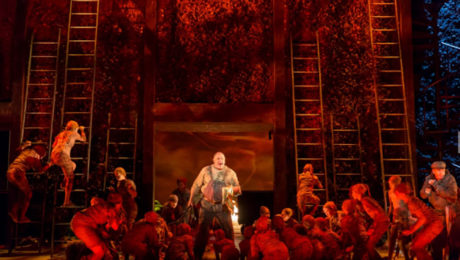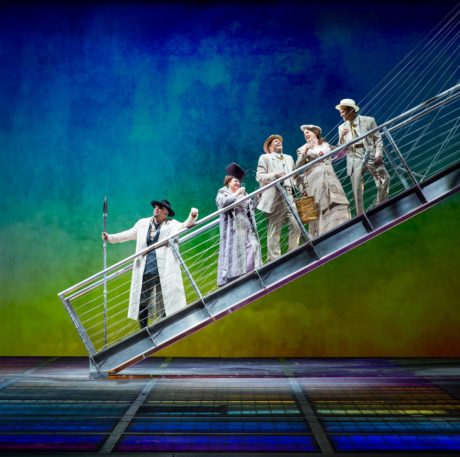German composer Richard Wagner’s much heralded and talked about (over the past many decades!) Ring Cycle opened at The Kennedy Center Opera House on Saturday evening with the first opera in the cycle, The Rhinegold. Many interpretations abound of this opera but it will take the entire cycle for one to decipher totally what interpretation Director Francesca Zambello is taking for, indeed, the Ring Cycle must be savored slowly as the majestic, stately, and persuasive orchestrations and the complex story demands.

In this initial opera, the genius “Midas touch” of the directorial interpretation is that Director Zambello treats the source material with great respect and reverence while, concurrently, adding fresh and invigorating yet subtly interwoven relevant and innovative interpretive touches. On the reverential side, each and every note is beautifully played and every line of sonorous text is delivered with pristine clarity and density. On the interpretive approach component, Ms. Zambello very subtly and unobtrusively intertwines an emphasis on nature and natural elements (to show the individual being cut off from as well as damaging the natural order of the universe),the use of contemporary costumes (Costume Designer Catherine Zuber shines), a decided accent on a critique of industrial mechanization/domination, and —especially— a sly, dry, ironic humor that pervades even the most dramatic moments of this absorbing opera.
The huge orchestra is astounding in its command of the precision yet enthralling mystical and magical essence of this opera. Indeed, the orchestra is the major character in this epic tale. Wagner’s use of the leitmotif is prevalent in the conducting of Philippe Auguin and the Washington National Opera Orchestra’s enthralling playing. The leitmotifs are distinctive melodic or harmonic ideas associated with a character, idea, event, mood or emotion. The leitmotif’s clearly-etched sound becomes the hallmark of a character’s identity and they envelop the epic structure (which is, also, decidedly intimately personal and specific in many moments of personal interaction and revelation).
These leitmotifs build with an accretion of musical power that propels the action onwards and adds a psychological depth to the proceedings that Zambello effectively takes advantage of. I was drawn into a dense labyrinth of a vast panoply of characters including Gods, Rhinemaidens (delightful erotic sprites of the River played beautifully by Renee Tatum, Jacqueline Echols, and Catherine Martin), Nibelungs and Giants. Aside from the magic ring, golden apples that delay the aging process and a magical, golden Tarnhelm (akin to a cloth-like piece—that, once worn, can make the wearer invisible or able to change identity at will) are prevalent.
The prolific genius of a composer, Richard Wagner, took 28 years to fully complete the entire Ring Cycle to final fruition and The Rhinegold is essentially an expository —yet captivating—prologue that serves to introduce one to the more complex plot machinations and development in the upcoming three operas that complete the entire Cycle. Wagner’s music undulates with a swirling, vertiginous, all-encompassing effect that entices with a rapturous appeal to the senses.

The inspiration of American Paintings by German-American painter Albert Bierstadt and American painter Frederic Church –embellished the crisp confidence of this interpretation as do the naturally immersive and pulsating visual projections that portray natural elements such as snow, rain, cascading water, and rocky ridges and clefts (these also serve to enhance rapt attention during intervals between scenes). Credit original projections designed by Jan Hartley and new projections designed and remounted by S. Katy Tucker.
Set Designer Michael Yeargan created several wondrously decorous and re-imagined worlds for the audiences to inhabit (alongside the marvelous players who dwell on the stage). The Rhinemaidens’ misty river and mountain dwelling (where they fail to guard the gold from Alberich’s greedy hands) is a luminous marvel. Yeargan also enthralls with his design of the lofty, celestial dwelling of the God Wotan (Alan Held) and his wife Fricka (the wondrous Elizabeth Bishop) and his wife’s sister (the sublime Melody Moore). Mr. Yeargan’s radical realization of the murky underground industrial dwelling where Alberich (Gordon Hawkins) controls his minions in order to fuel his coffers is chillingly effective and harrowing in its stark design.
The golden amber hues of the forging fires and the, alternately, grey and white celestial skies of the Gods’ habitations are set ablaze by the resplendent Lighting Design of Mark McCullough. McCullough’s lighting is evocative and highly creative throughout the entire opera.
The characterization and singing of American Tenor William Burden as Loge was a standout. This character could easily have been over played in lesser hands for Mr. Burden made him just “conniving enough” for this schemer of a character.
Gordon Hawkins’ portrayal of Alberich was daringly conceived as less of a repulsive monster and more of an angry, vengeful “mountain of a man” that one could identify with. Hawkins’ commanding Baritone shone throughout but, especially, as he contemplated the loss of the ring to Wotan.
As Wotan, Bass-Baritone Alan Held sang with authority yet concurrent sensitivity to each new scenario. Mr. Held beautifully elucidated the proper balance between his internal struggles with lust for greedy power and devout love for his family (Perhaps it is time to go back and look at Carl Jung’s famous analysis of these characters in earlier literature!). Mr. Held’s moments pondering the frustrations at building his new haven of an illustrious home were particularly interesting.
As Fricka, Goddess of Marriage and wife of Wotan, American Mezzo-Soprano Elizabeth Bishop‘s vast professional experience was evident throughout. Bishop’s robust yet crisp chest tones from her lower register added vigor and diversion to many of the scenes. Bishop’s portrayal was intriguing in that, though she is the Goddess of Marriage, she also presented her character as the ultimate “bourgeoisie” housewife—replete with nagging scolding of her husband, a penchant for jewelry, and a very conventional self-righteousness. A complex, precise, and amusing portrayal indeed!
American Soprano Melody Moore worked wonders with her character of Freia (Sister to Fricka). Ms. Moore’s stunning Soprano was employed to its utmost effect as he expressed her peril at being used as ransom (for her brother-in-law’s building of his own elaborate home, deemed as “Valhalla”). Ms. Moore also employed a sublime sense of humor when being returned by her captors and, consequently, almost being buried alive with mounds of gold!
David Cangelosi’s lustrous Tenor tones were conveyed with complete control as the character Mime.

Lindsay Ammann’s sensitive and reverberating Contralto was shimmering and evocative in her all “too-brief” stage time as Erda, Goddess of Wisdom, Fate, and Earth. As Ms. Ammann foretold of the destructive curse of the golden ring, I felt chills going through my very being.
As the Giants Fasolt and Fafner, Julian Close and Soloman Howard excitingly portrayed their characters as akin to gigantic, menacing and sardonic clowns. Mr. Close and Mr. Howard’s deep bass vocal tones served as comic counterpoint to their authentically realized —almost surrealistic —portrayals. Highly original and provocative!
Hearty Commendations are also in order for the singing of the Washington National Chorus and the coordination and enthusiasm of the Supernumeraries.
Director Francesca Zambello has reinvigorated The Rhinegold with exciting new dimensions while maintaining the unique and universal appeal of this artistic masterpiece.
A huge thunderous ovation is in order for the coordination of this entire ambitious effort and it can only portend major anticipation for the three upcoming operas in the Cycle.
Running Time: 2 hours and 35 minutes, with no intermission.
The Rhinegold was presented on Saturday, April 30, 2016 at 7 P M at The Washington National Opera performing at The Kennedy Center Opera House – 2700 F Street, NW, in Washington, DC. There are two remaining performances on May 10 and 17th at 7:30 PM. Tickets can be purchased online.
Upcoming operas in the Ring Cycle are The Valkyrie on Monday, May 2nd at 6 PM, Siegfried on Wednesday, May 4th at 6 PM, and Twilight of the Gods on Friday, May 6 at 5 PM. For tickets, purchase them online.
RATING:





This is one of the very best we have seen.
Andrejs